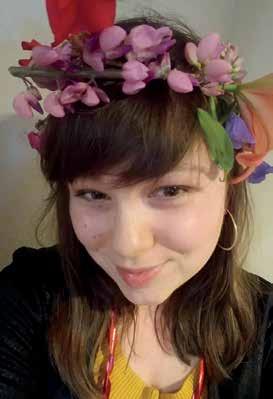
5 minute read
WELLNESS
THE BEST of KIDS’ RESALE


HOW IT WORKS
Lay your gently used kids’ stuff in a bin Browse the store while we appraise your items Choose your payout - Cash or 20% more in store credit
Saving Face:
Getting Help for Teenage Acne
By Malia Jacobson
Teenage acne is a common affliction — it affects up to 85 percent of adolescents, most often starting when kids are in middle school and sometimes continuing for decades. But if your teen is feeling more stressed about skin problems these days, they’re not alone. With more schooling, dating and socializing taking place via video chat, teens are often finding themselves in front of the camera without the benefit of flattering, blemish-removing social media photo filters, and they may not love what they see, notes Jacqueline Panko, M.D., a dermatologist with The Polyclinic in Seattle.
“Acne has been around for a long time, and it’s a concern for most teenagers at some point,” says Panko. “But with teens spending even more time on video, they may be more sensitive to how they’re showing up on camera right now.”
More than a cosmetic concern
Research shows that acne is far from a harmless hallmark of adolescence. Even after pimples heal, they can leave behind telltale scars and hyperpigmentation, or dark spots on the skin. According to a 2017 review of published research, acne Trendy treatments leaves physical scars up to 90 percent such as probiotic of the time. washes, handheld Acne also impacts teens’ mental health, according to a number of studies. One study found that about two-thirds of teenagers with acne high-frequency wands and light therapies haven’t reported that the condition had a been proven to work. moderate to severe negative impact on their mental well-being, interpersonal relationships and daily activities, including schoolwork and sports. Ongoing acne can lead to the development of problems involving body image, sexuality and socialization, according to research.
“We consider acne much more than a cosmetic concern,” says Panko. “The teenage years are a powerful time in someone’s life and development. Being able to face the world with clear skin can allow teenagers more confidence, so they can dream bigger and show up in the world more confidently.”
How a dermatologist can help
Teens who are bothered by pimples for more than a few months should consider seeing a dermatologist, says Panko. Acne is highly treatable, and treating it early may help prevent scarring and hyperpigmentation in the future.
A teen’s first visit to a dermatologist generally includes a comprehensive medical history (both personal and family) along with questions about which skin care products they’ve tried. “We’ll talk about what has worked and hasn’t worked in terms of treatments, then tailor a treatment plan to that patient’s specific needs,” says Panko. “Treatments may depend on whether a patient plays sports, where on the body the acne is, whether their skin is sensitive, and any other medications they may be taking.”
Treatment plans usually include a mix of topical creams or gels, oral antibiotics and possibly hormonal therapies such as birth control pills, says Panko. “We also talk to families about diet and sun exposure. Some UV light appears to help clear up
acne, so teens sometimes see acne clear up in the summer, but we also want to talk about protection against skin cancer. And although there aren’t many studies on acne and diet, it appears that high-glycemic diets with lots of processed foods are more inflammatory, so we encourage teens to eat healthy diets with fewer processed foods.”
Trendy treatments such as probiotic washes, handheld high-frequency wands and light therapies haven’t been proven to work, says Panko. “There are all sorts of treatments out there, but we can’t comment on those because they haven’t really been studied yet.”
Product parade
Concerns about the cost of treatment and fears that a dermatologist will push pricey products may keep families from seeking medical help for acne. However, the fact is that many dermatologists are fans of effective over-the-counter skin care products, and they can help guide teens toward the best drugstore options so they don’t waste time and money on ineffective, costly potions. (Who doesn’t need help sorting through the crowded skin care shelves?)
“Drugstore products are an excellent place to start,” says Panko. “Benzoyl peroxide is a very effective antibiotic for acne, and it’s an ingredient in lots of overthe-counter gels and washes. One of the nice things about it is that we don’t build up resistance to it — just be aware that it can bleach towels and linens.”
An over-the-counter retinoid with the brand name Differin can also work well, says Panko. “This is a product that used to be available by prescription only, and it’s now available at drugstores.” A topical retinoid can help rebuild collagen over time, which helps with redness and scarring.
Clear outlook
How long will teens need to wait to see results? Clearing acne does take some time, notes Panko, and teens may need to be patient. “We generally expect acne to be about 50 percent resolved after two months of treatment, and around 75 percent resolved by three months, which is around the time we’d want to see teens back for a follow-up visit.”
Getting help for acne can be empowering for teens, giving them more control over an important aspect of their physical and psychological well-being. Along with clearer skin, teen patients often gain a more positive outlook, says Panko. “Dermatologists are good at treating acne, and we’ve been doing it for a long time. Helping teenage patients with acne is rewarding; it’s satisfying to see a teenager clear their acne and rebuild their confidence. It’s a really fun relationship to have with a patient.” ■
Malia Jacobson is a health and family journalist.
Sponsored by:

For more than 100 years, The Polyclinic has served the Seattle community with a mission to promote the health of its patients with personalized care. Our team of more than 240 doctors and advancedpractice professionals provides care at 12 locations, offering primary care, nearly every medical and surgical specialty, and a comprehensive range of services, including lab, diagnostic imaging, urgent care, and an outpatient surgery center.
Healthy skin starts here.
Dr. Jacqueline Panko provides comprehensive dermatology care to patients of all ages. She welcomes new patients at The Polyclinic Ballard.









